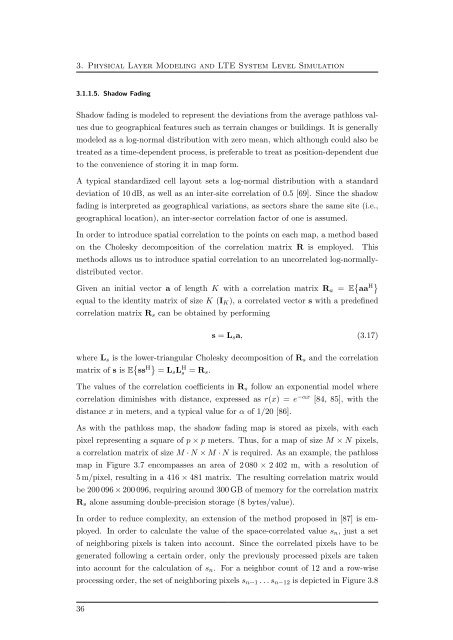System Level Modeling and Optimization of the LTE Downlink
System Level Modeling and Optimization of the LTE Downlink
System Level Modeling and Optimization of the LTE Downlink
- No tags were found...
You also want an ePaper? Increase the reach of your titles
YUMPU automatically turns print PDFs into web optimized ePapers that Google loves.
3. Physical Layer <strong>Modeling</strong> <strong>and</strong> <strong>LTE</strong> <strong>System</strong> <strong>Level</strong> Simulation3.1.1.5. Shadow FadingShadow fading is modeled to represent <strong>the</strong> deviations from <strong>the</strong> average pathloss valuesdue to geographical features such as terrain changes or buildings. It is generallymodeled as a log-normal distribution with zero mean, which although could also betreated as a time-dependent process, is preferable to treat as position-dependent dueto <strong>the</strong> convenience <strong>of</strong> storing it in map form.A typical st<strong>and</strong>ardized cell layout sets a log-normal distribution with a st<strong>and</strong>arddeviation <strong>of</strong> 10 dB, as well as an inter-site correlation <strong>of</strong> 0.5 [69]. Since <strong>the</strong> shadowfading is interpreted as geographical variations, as sectors share <strong>the</strong> same site (i.e.,geographical location), an inter-sector correlation factor <strong>of</strong> one is assumed.In order to introduce spatial correlation to <strong>the</strong> points on each map, a method basedon <strong>the</strong> Cholesky decomposition <strong>of</strong> <strong>the</strong> correlation matrix R is employed. Thismethods allows us to introduce spatial correlation to an uncorrelated log-normallydistributedvector.Given an initial vector a <strong>of</strong> length K with a correlation matrix R a = E { aa H}equal to <strong>the</strong> identity matrix <strong>of</strong> size K (I K ), a correlated vector s with a predefinedcorrelation matrix R s can be obtained by performings = L s a, (3.17)where L s is <strong>the</strong> lower-triangular Cholesky decomposition <strong>of</strong> R s <strong>and</strong> <strong>the</strong> correlationmatrix <strong>of</strong> s is E { ss H} = L s L H s = R s .The values <strong>of</strong> <strong>the</strong> correlation coefficients in R s follow an exponential model wherecorrelation diminishes with distance, expressed as r(x) = e −αx [84, 85], with <strong>the</strong>distance x in meters, <strong>and</strong> a typical value for α <strong>of</strong> 1/20 [86].As with <strong>the</strong> pathloss map, <strong>the</strong> shadow fading map is stored as pixels, with eachpixel representing a square <strong>of</strong> p × p meters. Thus, for a map <strong>of</strong> size M × N pixels,a correlation matrix <strong>of</strong> size M · N × M · N is required. As an example, <strong>the</strong> pathlossmap in Figure 3.7 encompasses an area <strong>of</strong> 2 080 × 2 402 m, with a resolution <strong>of</strong>5 m/pixel, resulting in a 416 × 481 matrix. The resulting correlation matrix wouldbe 200 096 × 200 096, requiring around 300 GB <strong>of</strong> memory for <strong>the</strong> correlation matrixR s alone assuming double-precision storage (8 bytes/value).In order to reduce complexity, an extension <strong>of</strong> <strong>the</strong> method proposed in [87] is employed.In order to calculate <strong>the</strong> value <strong>of</strong> <strong>the</strong> space-correlated value s n , just a set<strong>of</strong> neighboring pixels is taken into account. Since <strong>the</strong> correlated pixels have to begenerated following a certain order, only <strong>the</strong> previously processed pixels are takeninto account for <strong>the</strong> calculation <strong>of</strong> s n . For a neighbor count <strong>of</strong> 12 <strong>and</strong> a row-wiseprocessing order, <strong>the</strong> set <strong>of</strong> neighboring pixels s n−1 . . . s n−12 is depicted in Figure 3.836
















